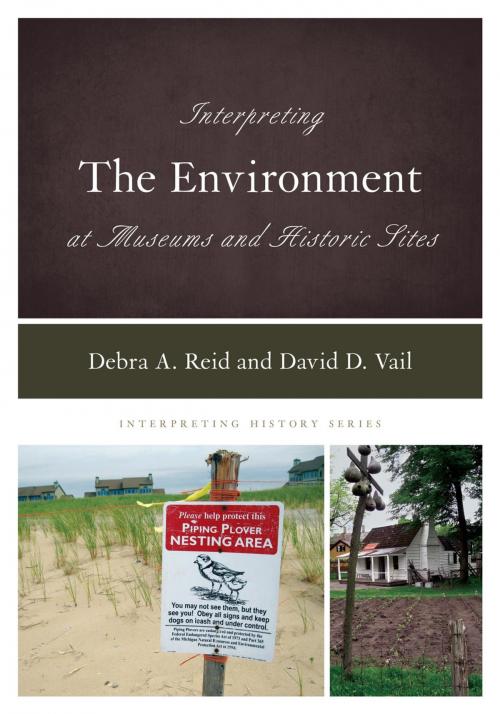Interpreting the Environment at Museums and Historic Sites
Nonfiction, Science & Nature, Nature, Environment, Environmental Conservation & Protection, Business & Finance, Industries & Professions| Author: | Debra A. Reid, David D. Vail | ISBN: | 9781538115503 |
| Publisher: | Rowman & Littlefield Publishers | Publication: | September 15, 2019 |
| Imprint: | Rowman & Littlefield Publishers | Language: | English |
| Author: | Debra A. Reid, David D. Vail |
| ISBN: | 9781538115503 |
| Publisher: | Rowman & Littlefield Publishers |
| Publication: | September 15, 2019 |
| Imprint: | Rowman & Littlefield Publishers |
| Language: | English |
Interpreting the Environment at Museums and Historic Sites is for anyone who wants to better understand the environment that surrounds us and sustains us, who wants to become a better steward of that environment, and who wants to share lessons learned with others. The process starts by focusing attention on the environment – the physical space that constitutes the largest three-dimensional object in museum collections. It involves conceptualizing spaces and places of human influence; spaces that contain layer upon layer documenting human struggles to survive and thrive. This evidence exists in natural environments as well as city centers. The process continues by adopting an environment-centric view of the spaces destined to be interpreted. This mind-set forms the basis for devising research plans that document how humans have changed, destroyed, conserved and sustained spaces over time, and the ways that the environment reacts. Interpretation built on this evidence then becomes the basis for minds-on engagement with the places that humans inhabit and the spaces that they have changed and continue to manipulate.
Interpreting the Environment at Museums and Historic Sites provides a tool kit designed to help you research environmental history, document evidence of human influence on land and the environment over time, and tailor that knowledge to new public engagement. It proposes a multi-disciplinary approach that requires expertise in the humanities as well as the sciences and social sciences to best understand space and place over time. It incorporates case studies of the theory and method of environmental history to explore how human goals take lasting shape in the environment – creating working environments, getting water, generating and harnessing power, growing food, traveling and trading, building things, and preserving natural landscapes.
Features include the Interpreting the Environment Tool Kit to help you launch the good work of interpreting the environment:
- Raw Materials (the evidence): landscape, ecosystems, artifacts, and the built environment
- Preparation (methods): thinking like a naturalist/scientist; thinking like a historian; combining approaches
- Planning (envisioning the goal): proactive message, stewardship, sustainability
- Partnerships (sharing work): strength in numbers; allying across disciplinary divides; united in efforts to inform the public about their individual and collective effects on the landscape and the environment
- Potential: educating the public about people and places is part of a world-wide goal with the cumulative effect of saving the planet, one story at a time.
- A Timeline and Bibliographic essay round out the book’s resources.
Interpreting the Environment at Museums and Historic Sites is for anyone who wants to better understand the environment that surrounds us and sustains us, who wants to become a better steward of that environment, and who wants to share lessons learned with others. The process starts by focusing attention on the environment – the physical space that constitutes the largest three-dimensional object in museum collections. It involves conceptualizing spaces and places of human influence; spaces that contain layer upon layer documenting human struggles to survive and thrive. This evidence exists in natural environments as well as city centers. The process continues by adopting an environment-centric view of the spaces destined to be interpreted. This mind-set forms the basis for devising research plans that document how humans have changed, destroyed, conserved and sustained spaces over time, and the ways that the environment reacts. Interpretation built on this evidence then becomes the basis for minds-on engagement with the places that humans inhabit and the spaces that they have changed and continue to manipulate.
Interpreting the Environment at Museums and Historic Sites provides a tool kit designed to help you research environmental history, document evidence of human influence on land and the environment over time, and tailor that knowledge to new public engagement. It proposes a multi-disciplinary approach that requires expertise in the humanities as well as the sciences and social sciences to best understand space and place over time. It incorporates case studies of the theory and method of environmental history to explore how human goals take lasting shape in the environment – creating working environments, getting water, generating and harnessing power, growing food, traveling and trading, building things, and preserving natural landscapes.
Features include the Interpreting the Environment Tool Kit to help you launch the good work of interpreting the environment:
- Raw Materials (the evidence): landscape, ecosystems, artifacts, and the built environment
- Preparation (methods): thinking like a naturalist/scientist; thinking like a historian; combining approaches
- Planning (envisioning the goal): proactive message, stewardship, sustainability
- Partnerships (sharing work): strength in numbers; allying across disciplinary divides; united in efforts to inform the public about their individual and collective effects on the landscape and the environment
- Potential: educating the public about people and places is part of a world-wide goal with the cumulative effect of saving the planet, one story at a time.
- A Timeline and Bibliographic essay round out the book’s resources.















